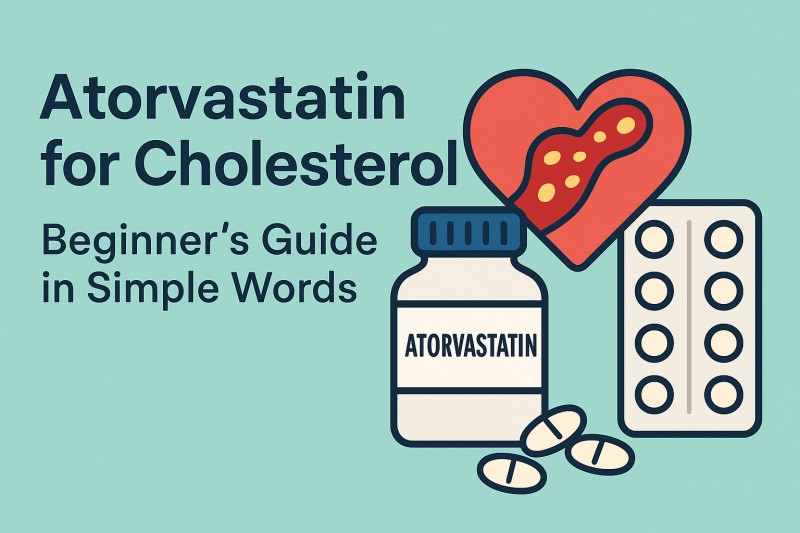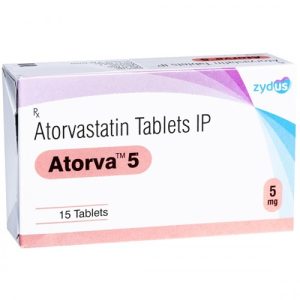One of the most prevalent health issues in the modern world is high cholesterol. To help manage it, doctors frequently prescribe medications known as statins. One of the most popular and reliable of these is atorvastatin. This beginner’s guide will explain everything in plain, easy-to-understand terms, whether you’ve recently been prescribed atorvastatin or you simply want to know how it works.
Atorvastatin: What is it?
One prescription medication that is a member of the class of medications known as statins is atorvastatin. These medications raise your blood’s levels of “good cholesterol” (HDL) while lowering “bad cholesterol” (LDL) and triglycerides. Atorvastatin lowers the likelihood of major issues including heart attacks, strokes, and clogged arteries by doing this. When diet and exercise alone are insufficient to reduce cholesterol levels, doctors typically prescribe atorvastatin.
Why is it important to control cholesterol?
Your blood contains a fatty material called cholesterol. A certain amount of LDL, or “bad,” cholesterol is necessary for your body to operate normally, but too much of it can adhere to the walls of your blood vessels. This accumulation, known as plaque, causes the arteries to constrict over time, making it more difficult for blood to flow. We refer to this condition as atherosclerosis.
Heart disease can result from uncontrolled cholesterol levels.
- A stroke
- Elevated blood pressure
- Disease of the peripheral arteries
For this reason, doctors frequently suggest medications like atorvastatin to control cholesterol levels.
Get and stay hard at 98% less cost!
Atorvastatin: How Does It Work?
The liver, which produces cholesterol, is where atorvastatin functions. It inhibits the HMG-CoA reductase enzyme, which is necessary for your liver to make cholesterol. Your liver produces less cholesterol when this enzyme is inhibited. Your liver also eliminates more LDL cholesterol from your blood at the same time. To put it simply, atorvastatin lowers bad cholesterol, increases good cholesterol, and decreases blood fat.
Common Atorvastatin Brand Names
Although atorvastatin is marketed under a number of brands, Lipitor is the most widely used. Numerous pharmacies also offer it as a generic medication, which functions similarly to the name-brand version but typically costs less. Always inquire about the brand you are prescribed by your physician or pharmacist.
For whom is atorvastatin appropriate?
Atorvastatin may be prescribed by doctors if you: Have elevated LDL cholesterol
- Possess a history of heart disease in your family
- Already experienced a stroke or heart attack
- Are susceptible to heart issues and have diabetes.
- Despite trying lifestyle modifications, high cholesterol levels persist.
Based on your medical history and cholesterol levels, your doctor will determine the appropriate dosage for you.
- The safest way to take atorvastatin is to take it once daily, with or without food.
- Timing: You can take it whenever you want, but try to take it at the same time every day.
- Diet: Keep up your good eating habits by consuming more fruits, vegetables, and whole grains and avoiding fatty, fried foods.
- Exercise: Regular exercise is the greatest way to get the most out of atorvastatin.
- Alcohol: Avoid excessive alcohol use as it may raise your risk of liver issues.
Potential Adverse Reactions to Atorvastatin
Like all medications, atorvastatin can have adverse effects, however most people use it without experiencing any significant issues. Typical ones consist of:
- Weakness or discomfort in the muscles
- A headache, unsettled stomach or nausea
- Joint discomfort
- Symptoms of a cold
Although they are uncommon, serious side effects can include allergic reactions, liver issues, or excruciating muscle pain. Get in touch with your doctor right once if you have unusual fatigue, yellowing of the skin or eyes, or black urine.
Safety Measures to Take Prior to Atorvastatin Use
- If you have liver illness or consume large amounts of alcohol, let your doctor know.
- Tell your physician about all of your medications, including herbal supplements.
- Atorvastatin should not be taken by women who are pregnant or nursing.
- To keep an eye on liver and cholesterol levels, routine blood tests could be advised.
Lifestyle Advice in Addition to Atorvastatin
Controlling cholesterol involves more than just taking atorvastatin. Combine it with healthy behaviors for optimal results:
- Consume a heart-healthy diet that includes lean proteins, more fiber, and fewer saturated fats.
- Keep moving by trying to get in at least 30 minutes of exercise most days.
- Give up smoking because it aggravates cholesterol issues and destroys blood vessels.
- Drinking too much alcohol causes triglycerides to rise.
- Keep your weight within a healthy range; even a slight decrease in weight can lower cholesterol.
Questions and Answers (FAQs)
- 1. How long does it take for atorvastatin to start working?
Although complete effects take a few months to manifest, you can notice results in as little as two to four weeks. Even if you feel fine, keep taking it.
- If my cholesterol is normal, may I discontinue taking atorvastatin?
No, never quit without first consulting your physician. Stopping abruptly could cause your cholesterol to climb again.
- Is long-term usage of atorvastatin safe?
Yes, with medical supervision, a lot of people use it for years.
- When taking atorvastatin, is it OK to eat grapefruit?
Large quantities of grapefruit or juice should be avoided as they may interact with the medication.
Concluding remarks
One of the best medications for reducing cholesterol and safeguarding your heart is atorvastatin. Consider it your blood vessels’ protection. Although it lowers cholesterol, it is most effective when combined with a balanced diet, consistent exercise, and lifestyle modifications.




